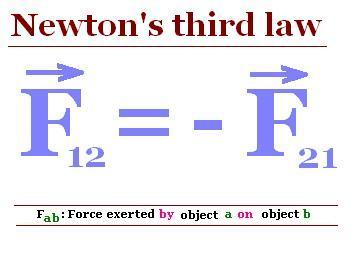Newton’s Three Laws
For a couple centuries before Einstein, Newton’s Laws were the basic principles of Physics. These laws are still valid and they are the basis for much engineering analysis today.
Newton’s First Law:
"An object at rest , will remain at rest until an unbalance external force acted upon it"
Inertia is a property of matter that resists changes in motion. If a mass is not moving, it will stay
that way until an unbalanced external force starts to move it; if a mass is in motion, it will stay in motion
with the same speed and direction until an unbalanced external force changes its motion characteristics
(friction could slow it down, or a force could accelerate its motion).
Example :
For example, let us consider a hockey puck on the ice (assume the ice is perfectly level and
frictionless). If the puck is placed down on the ice, it will stay motionless until someone hits it with a
stick or skate because of its inertia. Also due to inertia, when slapped, the puck will tend to move in a
straight line with constant speed until an external force (such as another player, or the goalie, or the net)
changes its motion.
Consider a body lying at the floor. it is in rest. it will always be in rest until an external force acted upon it.
a force F act on the mass m with some velocity v and the object or mass will be move. this is called newton's first law of motion.Newton’s Second Law:
"The applied force on a body is directly proportional to the acceleration produced in it"
Explain :
F ∝ a
F = ma
where :
m = mass of the body
Unit of
m = Kilogram
F = m(Vf – Vi / Δt)
F = Pf – Pi / Δt
F = ΔP/ Δt
In limiting case
F = Δp/Δt
The Rate of Change of momentum of a body is equal to applied force. This is called Newton's second law of motion.
Newton’s Third Law:
"For every action, there is an equal and opposite reaction."
This law is familiar in everyday situations; a force cannot be applied to an object unless
something resists the reaction of that force. In order to walk across the floor, you must push back on the
floor with your foot; then, according to Newton’s Third Law, the floor pushes forward on your foot,
which propels you forward. This, of course, requires friction to work. If a free-floating astronaut were
to throw a baseball, there is nothing to resist the throwing force, so as the baseball accelerates in the
direction of throwing, the astronaut would accelerate backwards, with a force equal and opposite to the
throwing force. The astronaut would accelerate at a much smaller level (by Newton’s Second Law)
since her mass is much greater than the baseball’s mass. The recoil of a gun during firing is another
example of Newton’s Third Law. As a final example, if a person attempts to jump to a dock from a
small sailboat, they may end up landing in water if they do not understand Newton’s Third Law: similar
to the astronaut example, the jumping force of the human on the boat will tend to push the boat
backwards; the equal and opposite force of the boat on the human will propel that person toward the
dock, but since the boat moves backwards, the person may end up wet. The same problem exists for
large sailboats, except with larger boat inertia, it is less noticeable.




No comments:
Post a Comment